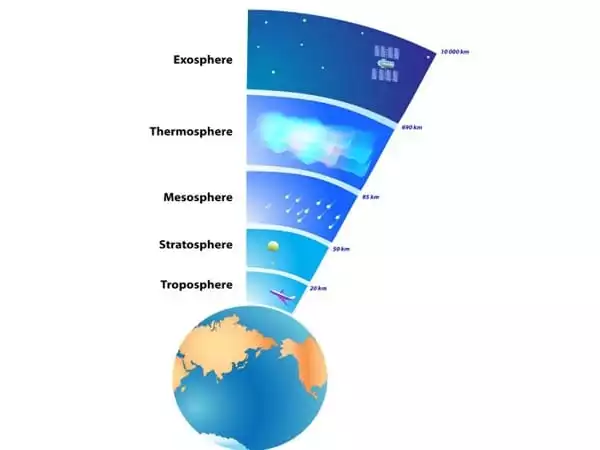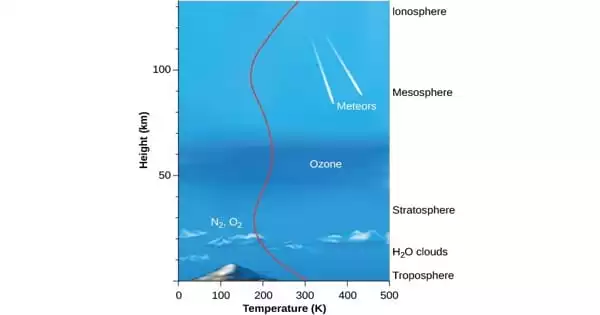According to a new international study, climate change is having an increasing impact on the structure of the Earth’s atmosphere. The study uses decades of data to show that rising temperatures are contributing to an increase in the top of the lowest level of the atmosphere by about 50-60 meters per decade.
The study, published in Science Advances, uses decades of weather balloon observations and specialized satellite measurements to calculate the extent to which the top of the atmosphere’s lowest level is rising. The tropopause is pushing up the boundary between the stratosphere and the atmosphere by about 50-60 meters (165-195 feet) per decade. Warming temperatures near the Earth’s surface cause the lower atmosphere to expand, causing the rising.
“This is an unmistakable sign of changing atmospheric structure,” said Bill Randel, a scientist at the National Center for Atmospheric Research (NCAR) and study co-author. “These findings confirm, in addition to all other evidence of climate change, that greenhouse gases are altering our atmosphere.”
Scientists from Nanjing University in China led the international research team. The study was partially funded by the National Science Foundation, which also serves as NCAR’s sponsor.
Climate change is having an increasing impact on the structure of the Earth’s atmosphere. This is an unmistakable sign of changing atmospheric structure. These findings confirm, in addition to all other evidence of climate change, that greenhouse gases are altering our atmosphere.
Bill Randel
Impacts from greenhouse gases, ozone-destroying chemicals
Depending on the season, the tropopause, an atmospheric region that separates the dense and turbulent troposphere from the overlying and more stable stratosphere, ranges from about 5 miles above the Earth’s surface at the poles to 10 miles at the equator. The tropopause’s location is of interest to commercial pilots who frequently fly in the lower stratosphere to avoid turbulence, and it also plays a role in severe thunderstorms, where overshooting tops can drive the tropopause higher and draw air from the stratosphere.
The steadily increasing height of the tropopause in recent decades has had little impact on society or ecosystems, but it demonstrates the far-reaching effects of greenhouse gas emissions. Previous scientific research has shown that tropopause is increasing. This was due not only to climate change but also to stratospheric cooling caused by ozone depletion. However, the 1987 Montreal Protocol and subsequent international agreements to limit ozone-destroying chemical emissions have successfully reversed ozone loss and stabilized temperatures in the lower stratosphere.

Randel and his co-authors used newly available data to calculate how much tropopause is still rising now that stratospheric temperatures are no longer a factor.
They primarily relied on two sources of information. One was a recently updated archive of radiosonde observations, which have been lofted high into the atmosphere on weather balloons for decades to measure atmospheric properties. Because radiosonde data is most detailed over Northern Hemisphere land areas between 20 and 80 degrees latitude, the new study focused on the rising height of the tropopause in that region.
The scientists also examined data from specialized satellite instruments dating back to 2002, which probe the atmosphere by measuring how much GPS radio signals bend and slow as they pass through the atmosphere. This novel technique, known as GPS radio occultation, was pioneered in part by the COSMIC (now COSMIC-2) satellite constellation, whose data is processed and disseminated by the University Corporation for Atmospheric Research, which manages NCAR.
The researchers then used statistical techniques to account for the impact of natural events such as volcanic eruptions and the periodic warming of surface waters in the eastern tropical Pacific Ocean known as El Nio. They were able to isolate the role of human-caused warming as a result of this.
Their analysis of radiosonde data revealed that the tropopause has risen steadily since 1980, at a rate of about 58-59 meters per decade, 50-53 meters of which is due to human-caused warming of the lower atmosphere. This trend has continued even as the influence of stratospheric temperatures has diminished, demonstrating that warming in the troposphere is having an increasing impact. Satellite observations since 2000 have confirmed that tropopause’s height has risen over the last two decades.
“The study captures two significant ways in which humans are changing the atmosphere,” Randel said. “Emissions of greenhouse gases are increasingly affecting the height of the tropopause, even as society has successfully stabilized conditions in the stratosphere by restricting ozone-destroying chemicals.”
















